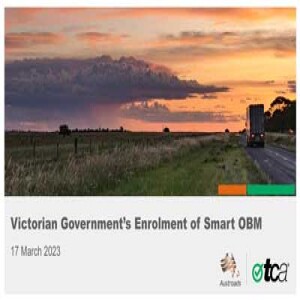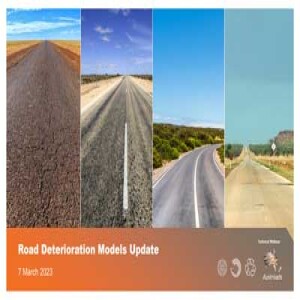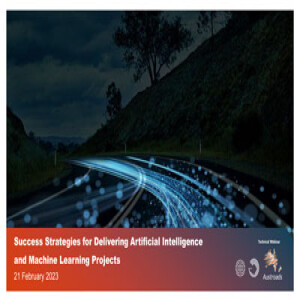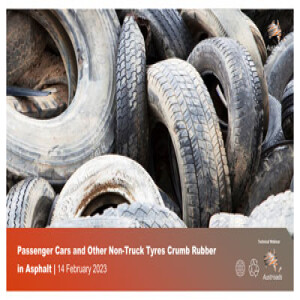Episodes

Wednesday Mar 22, 2023
Asphalt Laboratory Fatigue Relationships
Wednesday Mar 22, 2023
Wednesday Mar 22, 2023
The Austroads mechanistic-empirical design system documented in Part 2 of the Guide to Pavement Technology uses a laboratory fatigue relationship previously developed by Shell to predict the fatigue life of asphalt layers. The Shell fatigue relationship was developed over 40 years ago based on testing a selection of asphalt mixes from Europe and the USA. The mixes used to develop the original relationship are therefore unlikely to represent the modulus and fatigue behaviour of modern mixes (including mixes incorporating recycled materials) currently being used in Australia and New Zealand.
Austroads project Asphalt Laboratory Fatigue Relationship – Stage 1 Utilisation of Existing Data benchmarked available fatigue laboratory test results of locally manufactured asphalt mixes against the fatigue performance predicted by the generic Austroads fatigue relationship. The project also reviewed some important modulus and fatigue testing parameters that may affect the design of asphalt layers, including different sample preparation methods and the minimum number of test specimens required to develop a laboratory fatigue relationship.
This webinar with Joe Grobler, Dr Negin Zhalehjoo and Peter Bryant, presents the findings of the project, including the preliminary fatigue relationships developed for locally manufactured asphalt mixes with conventional (unmodified) bitumen.

Friday Mar 17, 2023
Victorian Government’s Enrolment of Smart OBM
Friday Mar 17, 2023
Friday Mar 17, 2023
The Department of Transport and Planning Victoria has announced 30 June 2023 as the final deadline to have smart on-board mass (OBM) systems fitted to certain high productivity freight vehicles (HPFVs).
Beyond this date, the mass limits of the below classes of vehicles will be restricted if not fitted with Smart OBM:
- vehicles more than 26m in length, with a Gross Combination Mass (GCM) in excess of 68.5 tonnes
- quad-axle semi-trailers with a GCM in excess of 46.0 tonnes
This webinar, presented by Gavin Hill and Ian Mond, covers:
- the changes and how they will affect transport operators traveling in/to Victoria
- the steps required for signing up to Smart OBM
- the importance of Smart OBM for the Victorian road network
- the ways mass data from Smart OBM is being used by road managers.

Tuesday Mar 07, 2023
Road Deterioration Model Update
Tuesday Mar 07, 2023
Tuesday Mar 07, 2023
Road deterioration (RD) models help in predicting future road condition and assessing maintenance needs. Austroads’ recent project updated the current Austroads RD models using the additional long-term pavement performance (LTPP) and long-term pavement performance maintenance (LTPPM) data as well as other available data, such as the traffic speed deflectometer (TSD) datasets, to improve these models’ explanatory power to support wider loading and the climate conditions observed in Australia. The updated and improved RD models can predict the impact of the wider loading and climate conditions observed in Australia.
The project produced four Austroads publications covering the updated RD models for cracking, strength (deflection), rutting and roughness. The project was managed in conjunction with the technical support of a Project Working Group sourced from industry and the road agencies. In addition, expert advice was sought from acknowledged experts in industry and academia.
Each of the reports documented a literature review of the state-of-the-art in deterioration modelling, a review of the available datasets for each of the RD models, the approach used to update each of the RD models and the validation of the rutting and roughness RD models.
This webinar with Dr Tim Martin, Ranita Sen and Tyrone Toole presents an overview of the methodology used to achieve the above objectives and the outcomes of the project.
The session covers:
- the basis for using the LTPP and LTPPM datasets for updating the RD models, including use of the TSD automatic crack detection (ACD) device data specifically for the update of the RD model for cracking
- the methodology adopted for updating the RD models
- validation of the rutting and roughness RD models.

Tuesday Feb 28, 2023
2022 Winners of the Austroads Bridge Awards
Tuesday Feb 28, 2023
Tuesday Feb 28, 2023
The webinar showcases the projects recognised with the Austroads Bridge Awards. The Austroads Bridge Awards acknowledge individuals and organisations that have delivered outstanding bridge structures and design across Australia and New Zealand.
The awards were presented at the 11th Austroads Bridge Conference held in Adelaide from 15 to 18 November 2022 proudly co-hosted by Austroads and the Department for Infrastructure and Transport South Australia.
The award-winning projects are:
Excellence in Innovation: InQuik Australia, Toorale Bridge Project
Submitted by InQuik, Alluvium Consulting Australia, and Pensar Infrastructure Group. Presented by Logan Mullaney, Managing Director of InQuik.
Excellence in Asset Management: Auckland Harbour Bridge Emergency Repairs
Submitted by Beca, WSP, SRG Global, Waka Kotahi NZ Transport Agency, and ASM Fulton Hogan-HEB Joint Venture. Presented by Will Pank, Technical Director – Structural Engineering, Beca.
Best Structure 35 metres or under: Hay Street Bridge Vertical Clearance Improvement Project
Submitted by BG&E, Bocol Constructions, MACA, and Main Roads Western Australia. Presented by BG&E’s Technical Director-Bridges Graeme Dundas, and WA - Bridge Lead Erica Smith.
Best Structure over 35 metres: Mandurah Bridge
Submitted by BG&E, Georgiou Group, Main Roads Western Australia, and City of Mandurah.
Presented by Boris Vujovic, BG&E’ Technical Director.

Friday Feb 24, 2023
Friday Feb 24, 2023
This is the second webinar in a two-webinar series. The session describes two case studies in the use of machine learning (ML) and artificial intelligence (AI) to create decision-support tools for pavement asset management.
In the first study, we explore whether ML can learn to reproduce expert treatment decisions and automatically identify candidate projects, using historic condition, treatment and inventory data.
In the second study, we explore extensions to conventional Pavement Management System (PMS) optimisation tools which provide insight into the network-wide implications of various multi-criteria funding allocation scenarios, and the levels of service that can potentially be realised.
The webinar is presented by Tim Cross and David Rawlinson.

Thursday Feb 23, 2023
Queensland’s Transition from IAP to TMA
Thursday Feb 23, 2023
Thursday Feb 23, 2023
The Queensland Department of Transport and Main Roads has announced upcoming changes which will harmonise the use of National Telematics Framework applications for heavy vehicles in Queensland with other jurisdictions.
These changes will include transitioning the subject vehicles from the:
- Intelligent Access Program (IAP) to the Telematics Monitoring Application (TMA)
- Interim On-Board Mass (OBM) Solution to Smart On-Board Mass (Smart OBM)
This webinar, presented by Gavin Hill from TCA and Mark Mitchell from the Queensland Department of Transport and Main Roads, provides an overview of the changes covering:
- the use of the National Telematics Framework to improve road outcomes
- the differences between IAP and TMA
- what’s behind the change
- what you need to know about the 18-month transition

Tuesday Feb 21, 2023
Tuesday Feb 21, 2023
Austroads has published practical guidance to help expand the use of artificial intelligence (AI) and machine learning (ML) in pavement asset management. AI/ML projects are notoriously prone to failure, including late or incomplete delivery, or even being abandoned without useful outcomes.
This webinar, presented by Tim Cross and David Rawlinson, is the first one in a two-webinar series. It describes the tips, tricks and success strategies we have found to avoid the common pitfalls and ensure AI/ML projects proceed to delivery and successful integration with existing business processes. The presenters introduce a Quick Reference document to help practitioners in their projects, and provide practical examples to explain how to use it.

Thursday Feb 16, 2023
Zebras and Wombats: Factchecking “False Sense of Security”
Thursday Feb 16, 2023
Thursday Feb 16, 2023
Decisions on how transport agencies provide for people walking to safely cross the roads has been greatly influenced by historical research, that has in the past failed to examine the infrastructure design and lacked behavioural data.
This webinar, presented by Mark McDonald, Principal Technologist (Bicycles, Pedestrians and Motorcycles) at the Queensland Department of Transport and Main Roads, looks at the different types of pedestrian crossing controls, behavioural responses of both drivers and people crossing and analyse the road safety implications. The presentation goes through the crash characteristics involved, including control of crash forces, analysis of crash braking patterns, the impact of uniform pavement marking on reaction times, speed and yield rates and crash reduction factors.
The webinar gives a review of safe system and evidence-based research relating to unsignalised crossings for people walking or riding bikes. It answers the questions: Who are we relying on? What is the safety evidence? Is “false sense of security” supported by evidence?

Tuesday Feb 14, 2023
Passenger Cars and other Non-Truck Tyres Crumb Rubber in Asphalt
Tuesday Feb 14, 2023
Tuesday Feb 14, 2023
This webinar focuses on the Austroads report Passenger Cars and other Non-truck Tyres Crumb Rubber in Asphalt: National Market Analysis, Review of Industry Practices and Technology Transfer.
The report provides a comprehensive overview of the fate and availability of end-of-life tyres from other-than-truck sources, such as passenger car tyres and mining and agricultural tyres, for road paving operations.
The webinar, presented by Anna D'Angelo from the Australian Flexible Pavement Association and Associate Professor Filippo Giustozzi from RMIT, discusses the market-readiness of Australia and New Zealand to use recycled crumb rubber in asphalt from a variety of end-of-life tyres rather than a single source (i.e. truck tyres).
The session provides information on the current tyre recycling industry across Australia and New Zealand and the evaluation of potential technological opportunities to produce crumb rubber in both countries.

Thursday Feb 02, 2023
Thursday Feb 02, 2023
In response to feedback provided by industry and stakeholders, Austroads has reviewed its Guide to Road Design Part 5: Drainage – General and Hydrology Considerations.
The improved guidance responds to the implications for road authority and consulting engineering practices arising from the 2019 update of the Australian Rainfall and Runoff document.
This is the second webinar in a two-webinar series, and it covers the improvements made to the Regional Flood Frequency Estimation (RFFE) method.
The following is discussed in the session:
- Background to the RFFE method
- Recent improvements to the RFFE method
- Worked examples
- Limitations of RFFE and how to assess the quality of the answers produced
The webinar is presented by WMAwater’s Managing Director Mark Babister and William Weeks, currently a private consultant and former Director - Hydraulics and Flooding for the Queensland Department of Transport and Main Roads.

